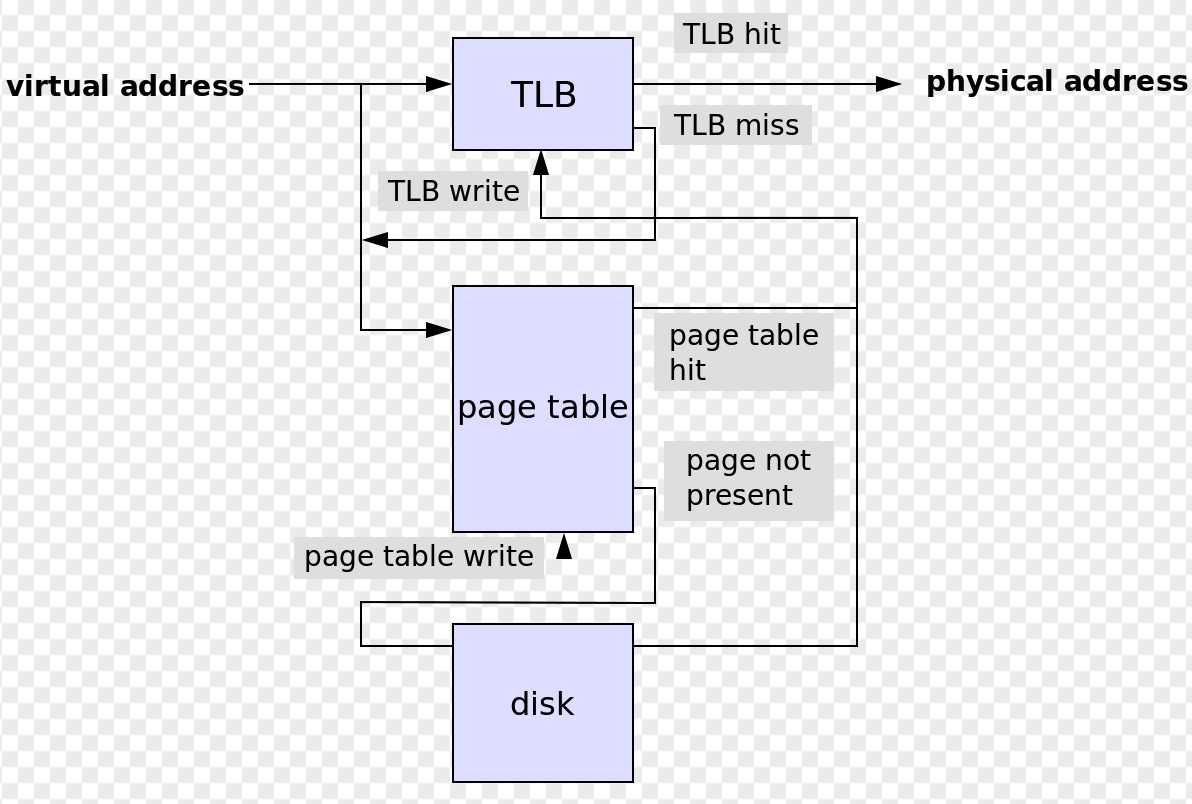Page (computer memory) Memory segmentation Page table 虚拟地址到物理地址的转换
A page, memory page, or virtual page is a fixed-length contiguous block of virtual memory, described by a single entry in the page table. It is the smallest unit of data for memory management in a virtual memory operating system. Similarly, a page frame is the smallest fixed-length contiguous block of physical memory into which memory pages are mapped by the operating system.[1][2][3]
A transfer of pages between main memory and an auxiliary store, such as a hard disk drive, is referred to as paging or swapping.
https://en.wikipedia.org/wiki/Page_(computer_memory)
A page, memory page, or virtual page is a fixed-length contiguous block of virtual memory, described by a single entry in the page table. It is the smallest unit of data for memory management in a virtual memory operating system. Similarly, a page frame is the smallest fixed-length contiguous block of physical memory into which memory pages are mapped by the operating system.[1][2][3]
A transfer of pages between main memory and an auxiliary store, such as a hard disk drive, is referred to as paging or swapping.[4]
#include <stdio.h>
#include <unistd.h> /* sysconf(3) */
int main(void)
{
printf("The page size for this system is %ld bytes.\n",
sysconf(_SC_PAGESIZE)); /* _SC_PAGE_SIZE is OK too. */
return 0;
}
内存分段(英语:Memory segmentation),一种电脑内存的管理技术,它将电脑的主内存分成许多区段(segment或sections)。当处理器要进行内存定址时,会使用一个数值,这个数值包括了某个区段,以及偏移量(offset)。一个程式的目的档(Object file)中也会使用区段,让它们可以链接成执行档,并载入内存中执行。
Memory segmentation is a computer (primary) memory management technique of division of a computer's primary memory into segments or sections. In a computer system using segmentation, a reference to a memory location includes a value that identifies a segment and an offset (memory location) within that segment. Segments or sections are also used in object files of compiled programs when they are linked together into a program image and when the image is loaded into memory.
Segments usually correspond to natural divisions of a program such as individual routines or data tables so segmentation is generally more visible to the programmer than paging alone.[1] Different segments may be created for different program modules, or for different classes of memory usage such as code and data segments. Certain segments may be shared between programs.[1]
Segmentation was originally invented as a method by which system software could isolate different software processes (tasks) and data they are using. It was intended to increase reliability of the systems running multiple processes simultaneously.[2] In a x86-64 architecture it is considered legacy and most x86-64-based modern system software don't use memory segmentation. Instead they handle programs and their data by utilizing memory-paging which also serves as a way of memory protection. However most x86-64 implementations still support it for backward compatibility reasons.[2] Moreover, segmentation is more of user's end of memory management scheme.[3]
https://zh.wikipedia.org/wiki/分頁表
在操作系统中使用虚拟内存,每个进程会认为使用一块大的连续的内存。事实上,每个进程的内存散布在物理内存的不同区域。或者可能被调出到备份存储中(一般在硬盘)。当一个进程请求自己的内存,操作系统负责把程序生成的虚拟地址,映射到实际存储的物理内存上。操作系统在分页表中存储虚拟地址到物理地址的映射。每个映射被称为分页表项(page table entry,PTE)。

The CPU's memory management unit (MMU) stores a cache of recently used mappings from the operating system's page table. This is called the translation lookaside buffer (TLB), which is an associative cache.[3]
When a virtual address needs to be translated into a physical address, the TLB is searched first. If a match is found (a TLB hit), the physical address is returned and memory access can continue. However, if there is no match (called a TLB miss), the memory management unit, or the operating system TLB miss handler, will typically look up the address mapping in the page table to see whether a mapping exists (a page walk). If one exists, it is written back to the TLB (this must be done, as the hardware accesses memory through the TLB in a virtual memory system), and the faulting instruction is restarted (this may happen in parallel as well). This subsequent translation will find a TLB hit, and the memory access will continue.
The page table lookup may fail for two reasons:
- The lookup may fail if there is no translation available for the virtual address, meaning that virtual address is invalid. This will typically occur because of a programming error, and the operating system must take some action to deal with the problem. On modern operating systems, it will cause a segmentation fault signal being sent to the offending program.
- The lookup may also fail if the page is currently not resident in physical memory. This will occur if the requested page has been moved out of physical memory to make room for another page. In this case the page is paged out to a secondary store located on a medium such as a hard disk drive (this secondary store, or "backing store", is often called a "swap partition" if it is a disk partition, or a swap file, "swapfile" or "page file" if it is a file). When this happens the page needs to be taken from disk and put back into physical memory. A similar mechanism is used for memory-mapped files, which are mapped to virtual memory and loaded to physical memory on demand.
When physical memory is not full this is a simple operation; the page is written back into physical memory, the page table and TLB are updated, and the instruction is restarted. However, when physical memory is full, one or more pages in physical memory will need to be paged out to make room for the requested page. The page table needs to be updated to mark that the pages that were previously in physical memory are no longer there, and to mark that the page that was on disk is now in physical memory. The TLB also needs to be updated, including removal of the paged-out page from it, and the instruction restarted. Which page to page out is the subject of page replacement algorithms.
CPU的内存管理单元(memory management unit MMU)存储最近用过的映射缓存,来自操作系统分页表。被称为转译后备缓冲器(translation lookaside buffer, TLB)。TLB是一个索引缓存。
当需要将虚拟地址转换为物理地址时,首先搜索TLB。如果找到匹配(TLB命中),则返回物理地址并继续存储器访问。然而,如果没有匹配(称为TLB未命中),则存储器管理单元或操作系统TLB未命中处理器通常会查找页表中的地址映射以查看是否存在映射(页面遍历)。如果存在,则将其写回TLB(这必须完成,因为硬件通过虚拟存储器系统中的TLB访问存储器),并且重启错误指令(这也可以并行发生)。此后续转换将找到TLB命中,并且内存访问将继续。
转换失败
有两种原因导致分页表查找失败。第一种,如果该地址没有可用的转换,这意味该虚拟地址的存储器访问是无效的。这通常是程序错误导致,操作系统需要处理这个问题。现代操作系统会发送一个段错误信号给出错程序。
当物理内存中不存在这个页,也会引起分页表查找失败。如果请求的页面被调出物理内存,给其他页腾出空间,会引起这个错误。这种情况下,页被分配到存储在介质上的辅助存储,例如硬盘。(这种辅助存储,或叫备用存储,如果是一个硬盘分区或者交换文件, 经常称之为交换分区,如果是文件,叫做分区文件或页文件。)这时候,分页需要从硬盘放回到物理内存中,这类操作通常会导致一种称为系统抖动(thrashing)的情况,通过局部性原理(principle of locality)来预测将来可能会访问的块,避免出现系统抖动。
当物理内存没满的时候,这是一个简单操作。页被写回物理内存,页表和转换备用缓冲会更新,指令重启。然而,当物理内存已满,一个或多个页要被调、为请求的页面腾出空间时候。页表需要更新,标识出那些在物理内存被调出的页,然后标识那些从硬盘调入物理内存的页。TLB也需要更新,包括去掉调出的页,重启指令。页的调入调出请见页置换算法。



